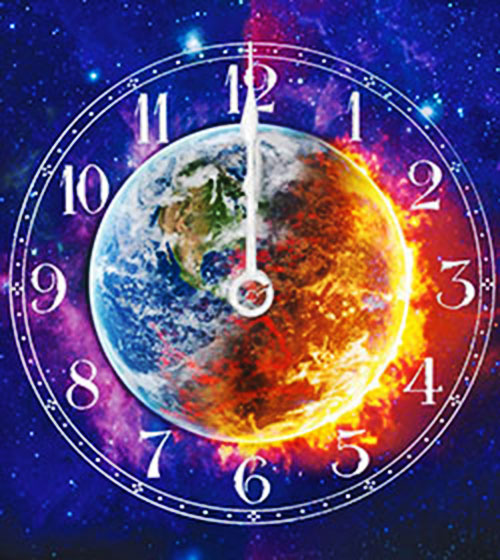|
New Dawn 152 (Sept-Oct 2015) from NewDawnMagazine Website
Part 1
The Anthropocene is a geological epoch characterized by the noticeable impact of humanity on the surface of the Earth. The previous epoch was the interglacial Holocene, which began after the fourth ice age.
The Anthropocene is said to have begun with the Industrial Revolution in the eighteenth century.
Others argue that substantial human influence on the lithosphere began up to 15,000 BP (BP=Before Present, the scale used for large periods of time) when human activity left its first traces on the rock record.
Others specify 1945 as a
clear date, due to the sudden arrival of radioactive material in the
rock strata from the explosion of atomic bombs.
This categorizing of history and prehistory is one of several examples where religious and esoteric ideas exist in a symbiosis with scientific and secular ideas.
Scientific concepts such as the ages of stone, bronze and iron owe their existence to myth:
The Anthropocene is partly a tool for highlighting the extent that humanity is currently influencing the global environment.
Yet it is typical of materialist science that only mankind's physical impact on the world is being assessed. Mankind appears in the geological picture mostly due to the damage we have done.
In contrast to this,
esoteric theories of eons, epochs and cycles typically see in
mankind a development towards an ever more spiritual form of
consciousness, or a descent from a golden age into barbarism, or the
repetition of cycles of a variety of divine or cosmic influences.
The best esotericism incorporates scientific and practical knowledge into a worldview that has a cosmic significance and acknowledges human psychological and spiritual development.
The technologies of esotericism are those of personal transformation and sacred science.
Esotericism is concerned with the inner meaning of whatever phenomena it touches upon, whether those of religion, myth or science.
We are so used to the gold, silver and bronze medals of the modern Olympics that the combination and order of these medals barely seems strange to us.
It was Hesiod in the eighth century BCE who first wrote of the ages of development associated with metals, and he was surely drawing on existing tradition.
Hesiod's account follows on from the story of Prometheus bringing fire to mankind and Zeus punishing humanity by fashioning Pandora with the aid of the other gods, whose infamous box unleashed evils and sufferings on the world, with Hope as the only positive quality.
Hesiod describes five ages:
In the golden age, ruled by the titan Kronos, humanity was free from labour and ill-health, people lived long happy lives and died peacefully in their sleep.
After death people lived on as good spirits of the earth who protect and bring wealth.
The silver race was
fashioned by and ruled by the Olympian gods. They were also
long-lived as children but once they grew to adulthood they fought
and were killed, forsaking the gods. These live on as spirits of the
underworld.
Our age is that of iron, to which Hesiod apportions a series of woes mixed in with only a little good meted out by the gods. Hesiod tells us he would rather that he had not been born than live in our age of iron.
Between the ages of bronze and iron was the heroic age. Its anomalous status, not being associated with a metal, suggests it was added to the scheme later.
The heroic age was the
age of the heroes and demi-gods of Greek myth, from the Seven at
Thebes to participants of the Trojan War. They live on in the
blessed isles.
Archaeological ages of materials technology, of course, show that bronze was used before iron was smelted. The modern scientific threefold scheme of stone, bronze and iron ages derives from Michele Mercati in the sixteenth century, with numerous subdivisions and refinements made as evidence accumulated and the scheme developed.
The scientific
understanding of archaeological ages of materials technology owes
its inspiration to the Greek myth of the ages of metal.
Lucretius was an Epicurean and in many ways a precursor of modern rationalism.
His method was not based on experimentation and measurement but on assigning natural materialistic explanations to phenomena. Hence, Lucretius ascribes mankind's knowledge of the use of fire not to Prometheus but from seeing forest fires caused by lightning.
He surmises that humanity learned to smelt metals from seeing the results of a forest fire on ore.
Lucretius sees mankind as
developing in phases from primitive technologies to the advanced
civilizations of his time, from using stone to copper or bronze, and
latterly to iron. It is the myth of progress.
Astrological ages and the
Indian Yugas (Hindu, though there are Buddhist and Jain adaptations
too) are probably the next well known, the latter chiefly among
those with spiritual, New Age or esoteric leanings.
There are additional
periods that precede and follow each Yuga, each 1/10 of the length
of the Yuga.
The Kali Yuga thus covers
the period from more or less the dawn of civilization to the
extremely remote future. These vast periods are difficult to find
meaningful.
The resulting periods mesh successfully with human affairs, with the current Kali Yuga conveniently ending in 1999. Despite Guénon's erudition, this surely amounts to convenient adaptation of a difficult idea; on the other hand it is the duty of esotericism to concern itself with the meaningful.
The best known resizing of the Yugas, possibly better known than the original periods, is that of Sri Yukteswar Giri, the guru of Paramahansa Yogananda, known widely for his Autobiography of a Yogi.
In Yukteswar's system of
Yugas the Kali Yuga has already ended and we are now in an ascending
era in which the Great Year runs in reverse. Thus the myths of
descent and ascent are combined.
As with the golden age of the Greeks, in the,
A distinctive Hindu characteristic of the ages is that they each have different numbers of avatars of the Lord Vishnu, with the Kali Yuga having only one, Kalki, who will return on a white horse to fight against the demon Kali (not to be confused with the goddess Kali) who is the ruler of the age.
In the official history of science it was Hipparchus in the 2nd century BCE who, on the island of Rhodes, computed the precession of the equinoxes (see graphic on page 62 in magazine).
In the 2nd
century CE Ptolemy, the great astronomer/astrologer, worked
out that precession was due to a wobble of the starry sphere.
Heliocentric science eventually determined that the wobble was in
Earth's orbit.
This number divided by 12
gives 2,147.5 years for an astrological age if the signs of the
zodiac are equally spaced.
The ages of Leo, Cancer and Gemini show mankind emerging from prehistory, with,
The age of Taurus began around 4000-4500 BCE, depending on the method of computation, and is associated with bull god cults such as those found in Egypt, Assyria and Crete.
Around 2000 BCE, give or take a couple of centuries, the spring equinox Sun moved into fiery and warlike Aries.
This was a time of empire building and heroic
ages, of martial conquest and the use of iron for weapons. It also
included the development of monotheism.
The fish associations of Christianity, the symbol of the vesica pisces, the fisherman disciples who become fishers of men, and several parables and miracles that include fish, are all consonant with Pisces.
Pisces is also notable
for its 'dreamy quality,' hence the characterization of the age
of Pisces as a time of deception.
This would make the astrological ages the arbiters of epoch par excellence. In these ages the position of the zodiac at the spring equinox aligns with chronology, mathematics and a zeitgeist that lasts for two millennia.
That zeitgeist manifests
through large scale human endeavor such as empire, war and
civilization, through symbolism and religious forms.
Although there is plenty
of argument over the specific beginning and ends of ages (though
their length is not so controversial), the scheme is admirable. It
is like a tool of the right size and weight that fits comfortably in
the hand.
The Greek system offers no development after the iron age. The Yugas offer an eventual return to the beginning of the cycle and a new golden age, which is a source of optimism. But the massive time scales and our place within the Kali Yuga can only allow us to sigh at the misery of mankind and its fall from grace.
The astrological ages cycle through varying qualities but are not characterized by ascent or descent.
When an age becomes tired and decadent, complementary qualities may be at hand in the influence of the forthcoming age.
Although both Christianity and Judaism have at times had their own strong astrological traditions, astrology was vulnerable to criticism as a pagan science whose symbolism and terms of reference didn't extol Yahweh or Christ as the foundation stones of the universe.
According to the astrological ages, the bull and the fish are merely passing fads, albeit fads of 2,000 years duration.
Thus it fell to
Christians to come up with their own eons and epochs that drew on
their own mythologies and understanding of the world. From a
Christian and Western standpoint, the Yugas and astrological ages
are merely turning around in circles.
Yet the line can still be divided into sections, marked out by the character of the times, by the stage in the process of the redemption of humankind.
The
Christian schemes take us out of the ancient world and into the
Middle Ages.
The BC/AD system did not take root for several centuries after its invention in the 6th century.
It reflected the basic
Old Testament/New Testament divide of the Christian Bible but has no
category for the Second Coming. It has no predictive quality
built into it.
Augustine's scheme utilized the seven days of creation. Inspired by Psalm 90:4 (quoted in II Peter 3:8), in which "one day with the Lord is as a thousand years," each day was literally a millennium.
The seventh age
corresponded to the seventh day, the Sabbath, on which day
God 'rested' from his labours, and was outside of
history.
The six ages were:
Thus we are living in the sixth age, which will continue until the Apocalypse.
The sixth age is clearly and uniquely Christian; all of the preceding ages are defined by Jewish figures yet are claimed for Christianity.
There is no accommodation
of, for instance, the Greek philosophers who would have lived in the
fifth age, or for Homer in the fourth age, no room to allow
for the Greek heroes or the Gods of Egypt, Greece, Rome and other
Mediterranean countries.
The great civilizations of antiquity, the gods and goddesses and daemons, are all swept away in favor of the purloined traditions of a people (the Jews) who weren't even included in the new religious dispensation unless they acknowledged Christ.
There was little room for
each age to have its own spiritual or psychological coloring or even
for a straightforward cycle of progress or corruption.
Barbelo, the divine feminine figure, visits Adam, then gives the seed to Seth, then later to the resurrected Christ. In the further reaches of Gnosticism we find similar demarcations of history based around important characters in the Bible.
Bardaisan came up with a scheme that involved 6,000 year periods that made up a Great Year.
The Manichaean religion is unusual in acknowledging both biblical figures from Adam and Seth down to Jesus and non-Abraham prophets including Zoroaster and Buddha.
Hence, the period from Adam to the birth of Jesus was the Age of the Father, characterized by the Law; from Jesus onwards was the Age of the Son, which was the age of the gospel; at some date in the near future would be the advent of the Age of the Spirit or Holy Ghost.
Abbott Joachim, who was a devout Catholic, believed the third age would bring the kingdom of God on Earth.
This third age would no longer require the Church (which was just an artifact of the second age) but would consist of celibate monks in direct communion with the Holy Spirit. Joachim believed the third age would dawn in 1200-1260 and so must have died believing it was imminent.
Joachim's influence on the development of Christianity would be indirect but considerable.
His concept of the replacement of the Church by saintly individuals would be picked up by various Protestant movements and lend itself to use by later antinomian Christian sects.
There was no compulsion
to accept Joachim's own estimate of the dawning of the Age of the
Spirit, therefore interest in his three ages would re-emerge in
aspects of twentieth century esotericism.
Minority Middle Eastern religions such as the Zoroastrians and the Yezidis also had their own schemes.
That of the Druze is notable for a scheme of eons that each last for an astonishing 343 million years. Other aspects of their little-known scheme include a series of 159 masters through history, in addition to the six prophets of Islam, with history deteriorating gradually until a final liberation takes place.
These 159 masters are pre-existent but are somehow controlled by Christ and the four evangelists as cosmic figures.
Outside of the scope of this article are the wide rage of mythic ages found around the world like the five Suns of the Aztec ages, or the Mayan calendar.
He has sometimes been characterized as the last magician rather than the first modern scientist. Newton believed that the true religion was that of Noah.
He also believed that the Sabaeans, Confucius, the Brahmins and Pythagoras all inherited this post-diluvian wisdom. As each of these figures and movements arose, the light of "true religion" renewed, only to decline steadily until the next renewal.
Egypt, however, according
to Newton, was responsible for much of the corruption and decline of
this true religion, including the concept of the Christian
Trinity, which Newton abhorred.
But Newton has integrated
figures like Pythagoras (and Hyram of Tyre, of Masonic fame)
into the scheme. Newton believed that Pythagoras gave mathematics to
the Greeks with one hand and the "true religion" with the other.
Esotericism is interested in the inner meaning and inner significance of traditions, usually sees religions and cultures as sharing fundamental principles (or often regarding as debased those that don't fit in) and hence can accommodate almost any criteria.
Given his scientific nature Newton saw these prophet figures as bringing sciences such as mathematics and astronomy with them.
Footnote
Part 2
The second part of this article, published in New Dawn 153 (Nov-Dec 2015), looks at how the concept of race was related to esoteric history, as well as the cycle cosmology of Theosophy, the "gyres" of W.B. Yeats, Thelema aeons, spin offs from G.I. Gurdjieff including Rodney Collin & J.G. Bennett, and the work of Jean Gebser and Peter Carroll.
|




